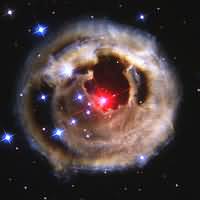B3 Astrophysics
Stellar Structure and Evolution
Dr Martin Bureau

Light echoes from the red supergiant star V838 Monocerotis.
Credit: NASA, ESA and H.E. Bond (STScI).
I will teach the Stellar Structure and Evolution section of
the B3 Astrophysics and Atmospheric Physics course this year
(Michaelmas term 2008). The lectures will follow the course developed
by Philipp Podsiadlowski in previous years, so both his lecture notes
and problems are adopted and appended below:
You can also download below the same lecture notes in colour, roughly
one chapter per lecture (non-examinable material in italics):
- Chapter 1: Introduction,
observable properties of stars, magnitudes, stellar classification
- Chapter 2: Stellar
properties, H-R (C-M) diagrams, star clusters, stellar populations,
brown dwarfs, planets
- Chapter 3: Equations of
stellar structure: hydrostatic equilibrium, virial theorem, stellar
timescales, energy transport by radiation and convection
- Chapter 4: Mathematical
problem, equations of state, opacities
- Chapter 5: Nuclear reactions:
nuclear binding energy, Coulomb barrier, non-resonant reaction rates,
hydrogen burning (pp chains, CN cycle), helium burning
- Chapter 6: Structure of
main-sequence stars, ages in open clusters, star formation,
evolution of low-mass stars: red-giant phase, helium flash,
horizontal branch, asymptotic giant branch, planetary nebulae, white
dwarfs, Chandrasekhar mass
- Chapter 7: Evolution of
massive stars, supernova types: core collapse and thermonuclear
explosions, supernova classification, SN 1987A, neutron stars, black
holes, gamma-ray bursts
- Chapter 8:
Binary stars: classification, mass function, Roche potential, mass
transfer, Algol paradox, binaries with compact components
- Appendix: Brown dwarfs,
planets, CNO tri-cycle, structure of the Sun, helioseismology, solar
neutrino problem, star formation, rings around SN1987a, gamma-ray
burts, elliptical orbits
To go back to my Home Page, click here:

This page was last modified on 17 October 2008


![]()